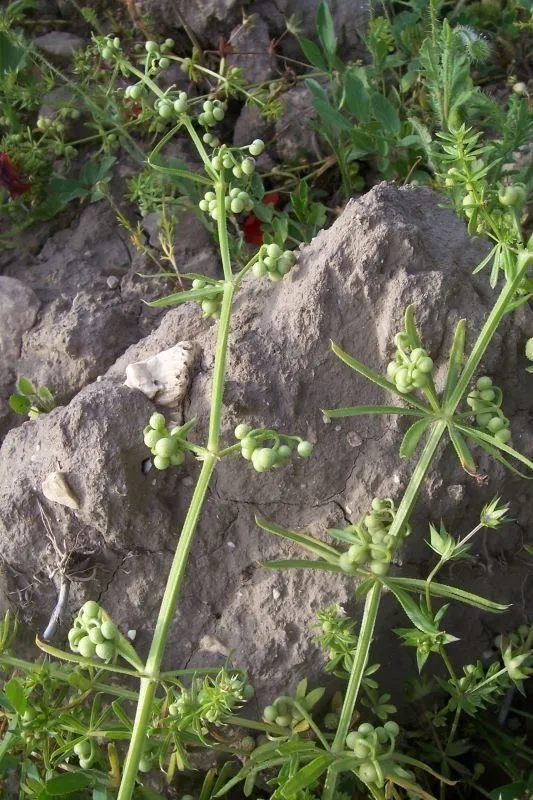
Author: Dandy
Bibliography: Watsonia 4: 47 (1957)
Year: 1957
Status: accepted
Rank: species
Genus: Galium
Vegetable: False
Observations: Europe to W. Himalaya and Arabian Pen.
Corn-cleavers, scientifically known as Galium tricornutum, is a fascinating plant that has gained attention both for its unique appearance and its broad geographic distribution. Belonging to the Rubiaceae family, this species is closely related to other Galium plants, often known as bedstraws or cleavers.
Galium tricornutum was authentically described by Dandy in a publication from 1957 in the prestigious botanical journal, Watsonia. This detailed description helped to elucidate its characteristics and place within the botanical taxonomy.
The plant is characterized by its delicate, slender stems and whorls of leaves that are arranged in groups of six to eight. The tiny white or greenish flowers are star-shaped and bloom in small clusters, adding to its ethereal beauty. One of the distinguishing features of Corn-cleavers is its hooked bristles, which allow it to cling to animals and human clothing, facilitating its spread.
Corn-cleavers is native to a broad range of regions, spanning from Europe to the Western Himalayas, and extending into the Arabian Peninsula. This wide distribution indicates a remarkable adaptability to varying climates and terrains, from temperate regions to more arid environments.
Despite its beauty, Galium tricornutum is often considered a weed in arable lands, where it can become quite invasive. Its ability to spread rapidly and cling to other plants and structures makes it a persistent presence in many agricultural settings.
In summary, Galium tricornutum, or Corn-cleavers, holds a significant place in the world of botany due to its unique attributes and widespread habitat. Its description by Dandy in the mid-20th century remains a critical reference point for botanists and plant enthusiasts alike.
Eng: corn cleavers, roughfruit corn bedstraw, corn-cleavers, rough corn bedstraw, corn cleavers, rough-corn bedstraw, three-horn bedstraw, rough-fruit corn bedstraw
Deu: dreihörniges labkraut
Fra: gaillet à trois cornes, gaillet à trois pointes
Dan: vorte-snerre
Nld: driehoornig walstro
Ces: lipkavec trojrohý, svízel trojrohý
Swe: pillermåra
Cym: briwydd arw, briwydden arw
En: Corn-cleavers, Three-horn bedstraw, Rough-corn bedstraw, Roughfruit corn bedstraw, Corn cleavers, Rough corn bedstraw, Rough corn bedstraw, corn cleavers, Rough-fruit corn bedstraw, Roughfruit Corn-bedstraw
Ar: غاليوم تريكورنوتوم
Az: Üçbuynuz qatıqotu
Ca: Rèvola de tres fruits
Cs: Svízel trojrohý, Lipkavec trojrohý
Da: Vorte-snerre
Nl: Driehoornig walstro
Fi: Sarvimatara
Fr: Gaillet à trois cornes, Gaillet à trois pointes
De: Dreihörniges Labkraut
He: דבקה משלשת
It: Caglio coriandolino
Mk: Трирогест еновец
Fa: شیرپنیر سهشاخی
Pl: Przytulia trójrożna
Es: Amor del hortelano con tres flores
Sv: Pillermåra
Cy: Briwydd arw, Briwydden Arw
© copyright of the Board of Trustees of the Royal Botanic Gardens, Kew.
© copyright of the Board of Trustees of the Royal Botanic Gardens, Kew.
© copyright of the Board of Trustees of the Royal Botanic Gardens, Kew.
Taken Oct 10, 2020 by Ithurralde Daith (cc-by-sa)
Taken Sep 26, 2021 by Shelley Brown (cc-by-sa)
Taken May 15, 2022 by Richard Wideman (cc-by-sa)
Taken Jun 9, 2014 by Tela Botanica − Jean-Jacques HOUDRÉ (cc-by-sa)
Taken Jun 9, 2014 by Tela Botanica − Jean-Jacques HOUDRÉ (cc-by-sa)
Taken May 15, 2004 by Photoflora – Jean-Luc TASSET (©)
Taken May 4, 2013 by Tela Botanica − Paul FABRE (cc-by-sa)
Taken May 20, 2018 by Ricardo Aperador Rubio (cc-by-sa)
Taken Apr 22, 2022 by Gonzàlez Niell Víctor (cc-by-sa)
Taken Jun 18, 2019 by Matt (cc-by-sa)
Taken Jun 3, 2014 by Tela Botanica − Paul FABRE (cc-by-sa)
Taken Jun 3, 2014 by Tela Botanica − Paul FABRE (cc-by-sa)
Taken Jun 3, 2014 by Tela Botanica − Paul FABRE (cc-by-sa)
Taken Jun 9, 2014 by Tela Botanica − Jean-Jacques HOUDRÉ (cc-by-sa)
Taken Oct 29, 2021 by Asiul Fenice (cc-by-sa)
Taken May 6, 2007 by EOL − Luigi Rignanese (cc-by-nc)
Taken Apr 14, 2014 by EOL − c michael hogan (cc-by-nc-sa)
Taken Apr 14, 2014 by EOL − c michael hogan (cc-by-nc-sa)
Taken Apr 22, 2018 by Tela Botanica − Sylvain PIRY (cc-by-sa)
Taken Apr 22, 2018 by Tela Botanica − Sylvain PIRY (cc-by-sa)
Taken May 26, 2012 by Tela Botanica − Bertrand BUI (cc-by-sa)
Taken May 4, 2013 by Tela Botanica − Paul FABRE (cc-by-sa)
Taken May 19, 2012 by Tela Botanica − Marie PORTAS (cc-by-sa)
Taken May 4, 2013 by Tela Botanica − Paul FABRE (cc-by-sa)
Taken May 31, 1853 by Tela Botanica − Herbier PONTARLIER-MARICHAL (cc-by-sa)
Taken May 4, 2013 by Tela Botanica − Paul FABRE (cc-by-sa)
Taken May 4, 2013 by Tela Botanica − Paul FABRE (cc-by-sa)
Taken May 23, 2015 by Tela Botanica − David MERCIER (cc-by-sa)
Taken Jun 9, 2014 by Tela Botanica − Jean-Jacques HOUDRÉ (cc-by-sa)
Taken May 23, 2015 by Tela Botanica − David MERCIER (cc-by-sa)
Growth habit: Forb/herb
Ph maximum: 8.0
Ph minimum: 7.5
Light: 7
Atmospheric humidity: 4
Bloom months: [‘jun’, ‘jul’, ‘aug’, ‘sep’]
Soil nutriments: 6
Family: Myrtaceae Author: (F.Muell.) K.D.Hill & L.A.S.Johnson Bibliography: Telopea 6: 402 (1995) Year: 1995 Status:…
Family: Rubiaceae Author: Pierre ex A.Froehner Bibliography: Notizbl. Bot. Gart. Berlin-Dahlem 1: 237 (1897) Year:…
Family: Sapindaceae Author: Koidz. Bibliography: J. Coll. Sci. Imp. Univ. Tokyo 32(1): 38 (1911) Year:…
Family: Asteraceae Author: A.Gray Bibliography: Pacif. Railr. Rep.: 107 (1857) Year: 1857 Status: accepted Rank:…
Family: Fabaceae Author: Medik. Bibliography: Vorles. Churpfälz. Phys.-Ökon. Ges. 2: 398 (1787) Year: 1787 Status:…
Family: Aspleniaceae Author: (Cav.) Alston Bibliography: Bull. Misc. Inform. Kew 1932: 309 (1932) Year: 1932…